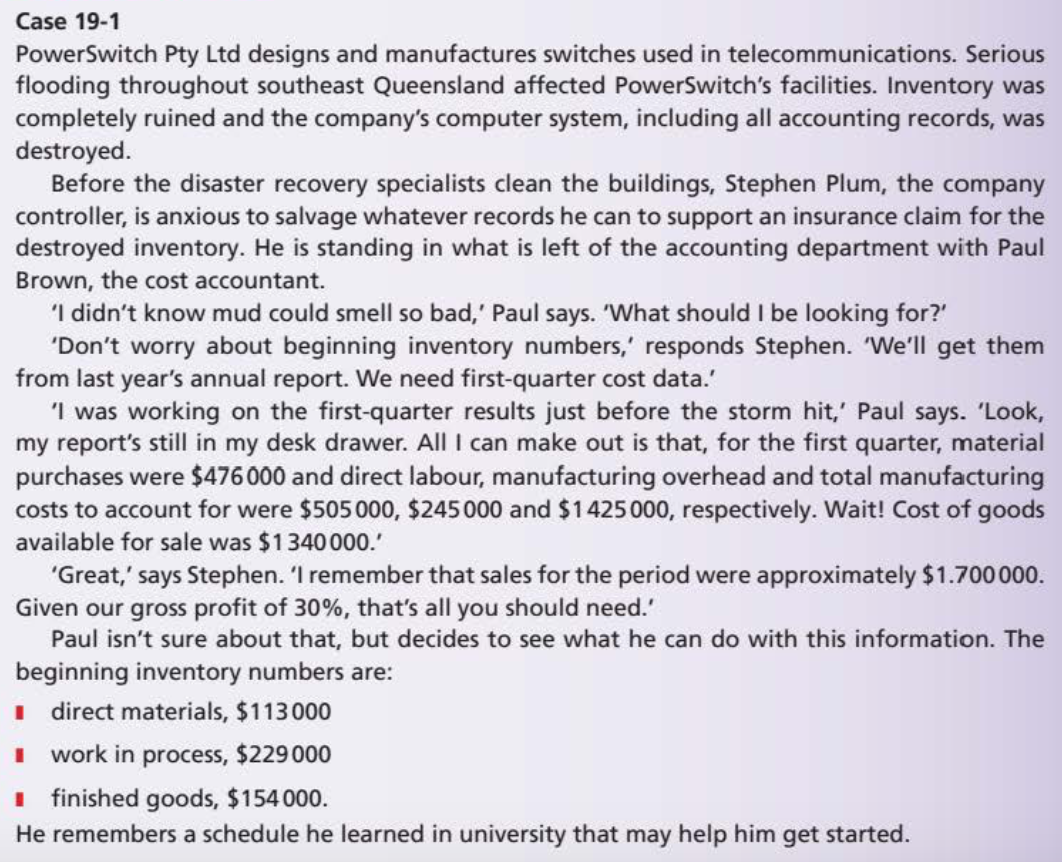
Requirements
-
1 Exhibit 19-10 resembles the schedule Paul has in mind. Use it to determine the ending inventories of direct materials, work in process and finished goods.
-
2 Itemise a list of the carrying amount of inventory lost.
Case 19-1 PowerSwitch Pty Ltd designs and manufactures switches used in telecommunications. Serious flooding throughout southeast Queensland affected PowerSwitch's facilities. Inventory was completely ruined and the company's computer system, including all accounting records, was destroyed. Before the disaster recovery specialists clean the buildings, Stephen Plum, the company controller, is anxious to salvage whatever records he can to support an insurance claim for the destroyed inventory. He is standing in what is left of the accounting department with Paul Brown, the cost accountant. 'I didn't know mud could smell so bad,' Paul says. 'What should I be looking for?' "Don't worry about beginning inventory numbers,' responds Stephen. 'We'll get them from last year's annual report. We need first-quarter cost data.' I was working on the first-quarter results just before the storm hit,' Paul says. 'Look, my report's still in my desk drawer. All I can make out is that, for the first quarter, material purchases were $476 000 and direct labour, manufacturing overhead and total manufacturing costs to account for were $505 000, $245 000 and $1 425 000, respectively. Wait! Cost of goods available for sale was $1340 000.' 'Great,' says Stephen. 'I remember that sales for the period were approximately $1.700000. Given our gross profit of 30%, that's all you should need.' Paul isn't sure about that, but decides to see what he can do with this information. The beginning inventory numbers are: I direct materials, $113000 work in process, $229000 I finished goods, $154000. He remembers a schedule he learned in university that may help him get started. Case 19-1 PowerSwitch Pty Ltd designs and manufactures switches used in telecommunications. Serious flooding throughout southeast Queensland affected PowerSwitch's facilities. Inventory was completely ruined and the company's computer system, including all accounting records, was destroyed. Before the disaster recovery specialists clean the buildings, Stephen Plum, the company controller, is anxious to salvage whatever records he can to support an insurance claim for the destroyed inventory. He is standing in what is left of the accounting department with Paul Brown, the cost accountant. 'I didn't know mud could smell so bad,' Paul says. 'What should I be looking for?' "Don't worry about beginning inventory numbers,' responds Stephen. 'We'll get them from last year's annual report. We need first-quarter cost data.' I was working on the first-quarter results just before the storm hit,' Paul says. 'Look, my report's still in my desk drawer. All I can make out is that, for the first quarter, material purchases were $476 000 and direct labour, manufacturing overhead and total manufacturing costs to account for were $505 000, $245 000 and $1 425 000, respectively. Wait! Cost of goods available for sale was $1340 000.' 'Great,' says Stephen. 'I remember that sales for the period were approximately $1.700000. Given our gross profit of 30%, that's all you should need.' Paul isn't sure about that, but decides to see what he can do with this information. The beginning inventory numbers are: I direct materials, $113000 work in process, $229000 I finished goods, $154000. He remembers a schedule he learned in university that may help him get started







